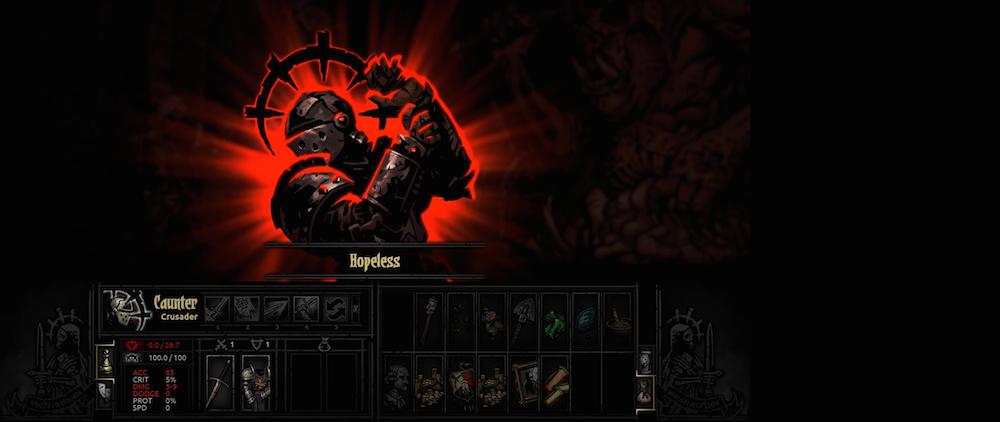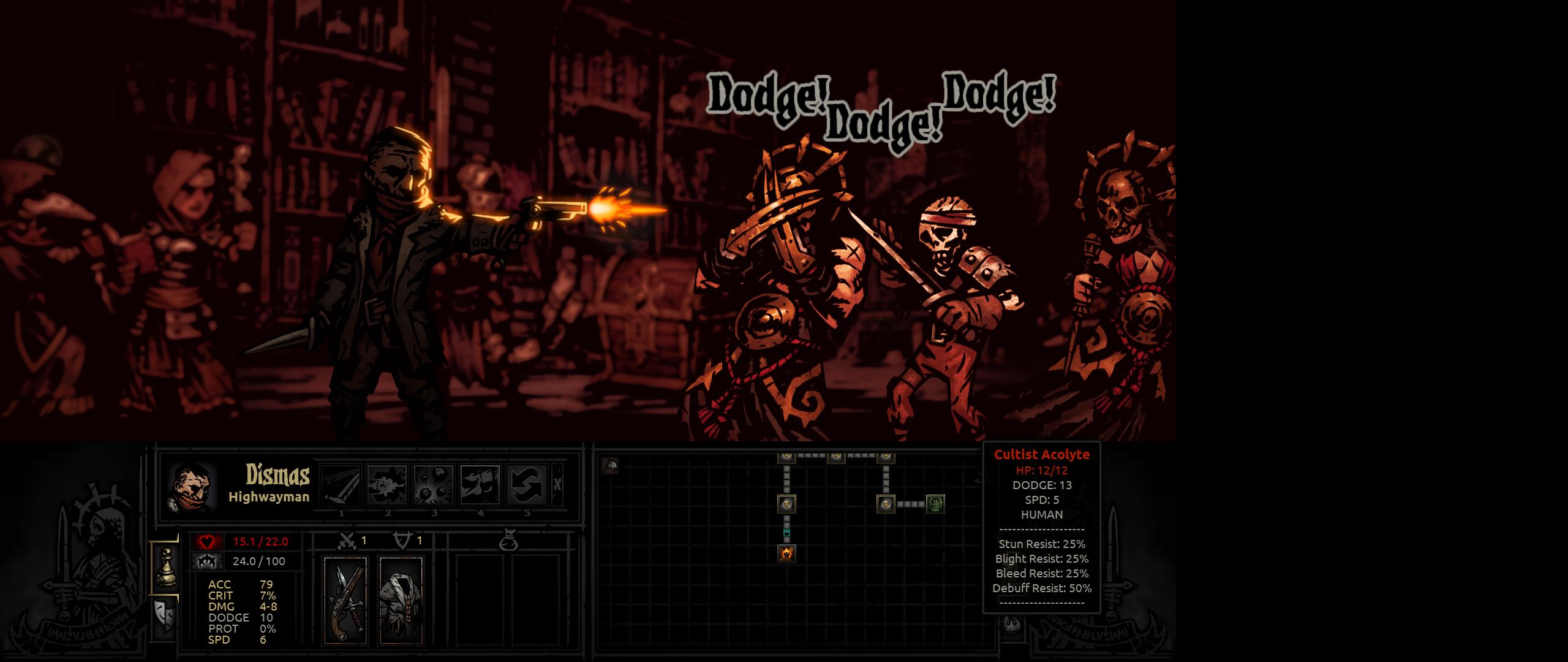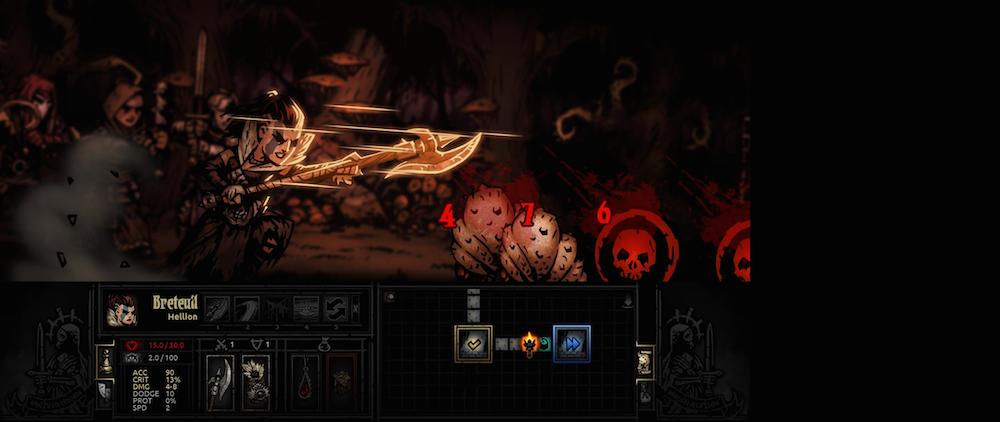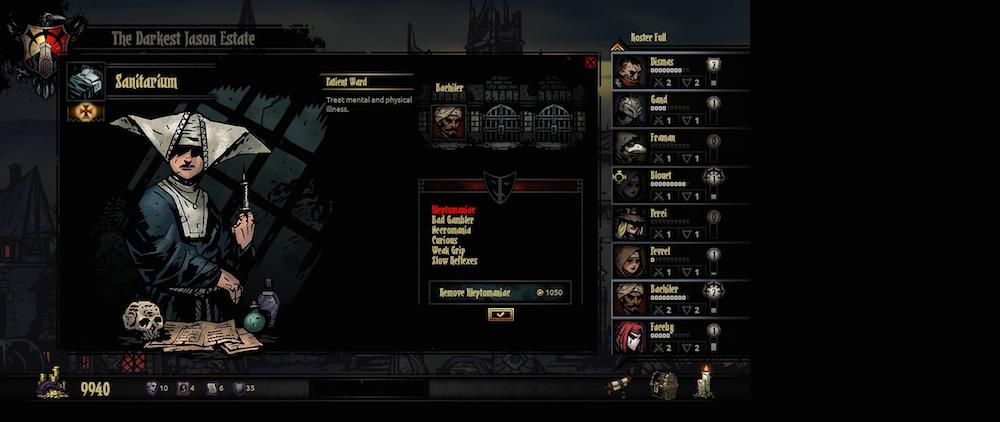The first sign that I was playing something unique — a rarity in my 30-plus years of taking on role-playing games — came after my first encounter in Darkest Dungeon. I looked at my Vestal, the priest character with healing powers, for a spell to cast after combat to cure my Crusader, as I’ve done in dozens of games before. He’d take a copious amount of damage from some brigands.
No such spell existed. In fact, I learned you couldn’t even use your characters’ abilities between encounters.
I smiled, to no one in particular. “Well, this is going to be different,” I chuckled.
This is the world that sprung from Red Hook Studios’ first game. A Kickstarter success in 2014, Darkest Dungeon recently hit the Steam digital store’s Early Access Program, enabling a host of RPG fans (err, test subjects?) to check out this stressful take on dungeon-crawling and roguelikes. It takes many genre conventions and, well, gives them a swift kick to the groin. You must take risks. You don’t hoard healing potions and other useful items. Expect your characters to die. And expect to fail.
I talked with studio cofounder and game designer/producer Tyler Sigman and cofounder Chris Bourassa, who is also the creative director and artist, on what could be the first “RPG noir,” the influence of Lovecraft and gothic horror, balancing risk and reward and sacrifice, and Sarah McLachlan.
Wait, Sarah McLachlan?
Welcome to Darkest Dungeon, indeed.
GamesBeat: Are you guys sadists?
Chris Bourassa: No? Not that we’ve commented on publicly.
Tyler Sigman: Our public persona is not. I think we’re realists. We both—I don’t know. We’ve been working for a number of years, had a lot of management jobs, personal lives, etc. All those things have led to inspiration for the game, for sure, the kind of suffering that you sometimes have to do on the way to trying to accomplish something good.
Bourassa: We always wanted to make a challenging game. We’ve both been managers for a while and both played poker together for a while. This is kind of like management poker.
GamesBeat: The one thought I had, and this kind of goes with the avatar Tyler uses on social media, is that it does have the gothic feel to it, but there’s also a noir feel. Was that something you were shooting for?
Bourassa: Yeah, in the sense that everything that can go wrong will go wrong in a noir. There’s definitely some overlap there. I started trying to make it look more like an old illuminated manuscript or medieval woodcut, just to give it that feeling that when you’re playing the game, it’s almost like it’s describing the time period it’s from. But I think there’s some—you could argue there’s some noir there. Maybe not overtly. I didn’t watch a bunch of detective movies before starting the game. But the stories you can weave feel a little bit like noir adventures.
Sigman: The flaws—it’s interesting. Chris drew avatars for all of us on the team in the style of the game. That is representative of his creative direction. There are flaws in the characters, just like in noir, where the detectives solving the case are usually—if you read James Ellroy or whatever, there’s a lot of flaws in the heroes. It’s funny, because as Chris drew each of our avatars, almost every person he drew said, well, my nose isn’t quite like that. Do I really have those tired-looking eyes? Do I look that hollow? It’s funny. Those images are—the flaws are key to the characters in Darkest Dungeon, as it were. We’re conscious of our own as well.
Bourassa: Even more so now, having been through development.
GamesBeat: The patch that just came out on Feb. 11. Heroes don’t like it when you prolong combat unnecessarily. I remember somebody said, “you god damn monsters.”
Sigman: Yeah, [game streamer] Northernlion.
.@DarkestDungeon patch: "Heroes don't like it when you prolong combat unnecessarily" you god damned monsters
— Ryan Letourneau (@Northernlion) February 11, 2015
GamesBeat: When the game first hit early access, one of the things you suggested people do is stun the enemies, and that way you could manage combat better. That prolongs it. Now here you are completely neutering that advice. Was that part of your plan, to fit the theme of the game, or is it just a reaction to try and stay ahead of players?
Sigman: We haven’t neutered stunning. I think the inspiration for a lot of the mechanics in the game has been the theme. That’s something that’s really important to us. Even in this change we added a couple of days ago — as you said, heroes don’t like it when you prolong combat unnecessarily — we think that’s really thematic. If you’re in a battle and you’re toying — it’s a bit like Apollo Creed toying with Rocky and not realizing the guy can punch. If you toy with something, sometimes you get the bite end of that. And so I think stunning is still really valid, because you can basically render a really damaging enemy momentarily [irrelevant] without an attack. But the stun-locking in particular, I think, it takes away from the game. It was something we knew was in there, but we were curious to see how many people would abuse it. It was always on our road map to address it in a way that was both thematic and fair, because the other thing is, we added a stun recovery buff. That applies to heroes as well. That’ll sometimes be nice. Your best crusader’s been stun locked for a couple of turns, it’s less likely to happen to him now as well.
Bourassa: I think the game is at its best when you feel like you’re playing with a high level of risk and reward. We were seeing a lot of people just stun locking the last enemy, healing up to full, dropping stress down to zero. All the tension was lost.
GamesBeat: Yeah, that was me.
Bourassa: I was getting furious watching people do it. I was like, no, the players themselves need to be more stressed out. So that was the rationale behind addressing that. It’s not to take away a viable stun strategy, which is still in the game and works really well, but just to curb that abuse and keep the game tense.
Sigman: We thought about other ways to address it, but I think this is both thematic and fair. It’s definitely an interesting concern. I think we’re never going to make apologies for trying to shape the game in a way that we think will be the most interesting. That’s something, for example—you can’t heal outside of combat. A lot of people want to ask why. They want to know the fiction. There’s kind of a great quote from Sid Meier, which is never let history get in the way of fun. Although this is not history, I think it’s an insightful approach. We want you to feel some of these things with Darkest Dungeon. If someone goes and mods it — which they have, and it’s cool — that’s fine, to make it easier. But we want you to suffer a little bit.
GamesBeat: It’s interesting that you say that about history, because if you take it into the context of Darkest Dungeon, you’re not talking about history as in the timeline we’ve been in, but you can think of it as the history of RPGs.
Sigman: That’s true. Chris and I were both inspired by a lot of classics.
GamesBeat: You funded this on Kickstarter. Did all the money come from there, or did you have another source?
Bourassa: No, we were all just bootstrapping. Kickstarter helped us go to shows like PAX. It kept us going. But we were bootstrapping before that and we’ve been bootstrapping since. Our Early Access launch was the first time that we were in a position to start paying ourselves salaries.
GamesBeat: One thing I’ve noticed is that you’re still really high up there in sales on Steam. Have you sold more copies through Steam than through Kickstarter at this point?
Sigman: Far more on Steam. We’ve been blown away. We’re not quite ready to release numbers. We may at some point, because some other developers out there have released numbers and it’s been really helpful. But we’re still just taking it in. Kickstarter is interesting, because you also sell at a higher average price. You have external rewards. We’re going to be delivering artbooks and prints and things like that. I think we sold around 9,600 on Kickstarter. We took pre-orders on Humble, which was maybe another 1,000 copies combined. But we’ve done a lot more than that on Steam so far.
Bourassa: We’ll release a number at some point. We don’t want to speculate. It’s only been a week and a half, too. I don’t want to call the shot just yet.
GamesBeat: Of course everyone keeps saying Lovecraft when they talk about this game. I think about Ravenloft, from Dungeons & Dragons. Did you guys play that at all?
Bourassa: I had a Ravenloft module. I never really learned how to play D&D properly, but I read it cover to cover several times. That might be in there somewhere. Really, the central idea was to try to bring Lovecraft into the Middle Ages, to get him out of the 1920s.
Sigman: Yeah. Definitely played some Ravenloft in the past, in my pen and paper days, but it never came to mind in our discussion. A lot of those things — even traditional high fantasy didn’t really guide — I suppose it guided us a bit in the sense that we knew from the beginning we didn’t want to do fireball spells and healing potions. Not that there’s anything wrong with that, but it just that there are so many RPGs out there doing that. We wanted to steer away from that. The other thing is, some of those powerful magics and instant heals, it kind of goes against what we’re trying to make you feel, which is that adventuring has a cost. It has a mortality and a peril and a cost. If you can just quaff healing potions every time your globe gets almost empty, the only threat you’re feeling is a reactionary, dexterity threat. Can I hit the potion button fast enough? Darkest Dungeon is more about the slog and the long peril and how far you can push before it’s too late.
GamesBeat: This felt so pen and paper-y to me that I thought it was actually based on a campaign you might have run. But it’s not?
Bourassa: We took a lot of inspiration from board games and some pen-and-paper stuff. We had the Mordheim book kicking around for a while. So yeah, there’s definitely a strong tabletop current in the game.
GamesBeat: As you make tweaks during Early Access, do you ever feel like you’re kind of pulling the ball away from Charlie Brown?
Bourassa: I think we’re actually adding more balls. As we refine the balance, especially, new tactics will open up. We want to give people a sandbox to play in. We only really want to shut the doors that we feel are exploitative, that undermine our intended experience coming out of the game. We’ve seen a lot of people do dark runs and things like that. Looking at that, there might be some opportunity to add even more tools to the toolbox, just based on what we’ve seen. It’s going to be an exciting early access from that standpoint.
Sigman: We definitely don’t want to take away things that work, if that makes sense. The stun locking was a pure exploit that goes against the DNA of the game. But if someone has a good tactic – hey, here’s a really good way to tackle the swine prince or the hag, you bring this particular party and make sure to get trinkets that do this, bring these particular skills, camp right before and have the bounty hunter prepare for the big battle – that’s exactly what we want people to do.
Bourassa: If you can wreck the boss by doing that, you deserve to wreck the boss.
GamesBeat: One thing I’ve noticed on social media and forums after the tweak is that people seem to be taking it in the spirit that you intended. It’s not that you’re taking something away, just that you’re trying to keep the game true to your vision. I don’t see anyone really getting mad or yelling all that much. Has that been your experience?
Bourassa: There was a little bit of noise at first. It feels good to land crits in our game. I’m really happy about that. People were feeling good in the dark with three Hellions just wrecking shop. There was a bit of backlash against maybe not being able to do that as much. But yeah, like Tyler said, we’re in early access for that exact reason. We’re going to try all kinds of stuff. We’ll play with balance and tune numbers. For a week maybe you’re not going to crit that much and then next week you’ll crit a lot. I don’t know what we’re going to do, but it’ll be in service of the central vision of the game we have. We’re hoping that our players will have fun enjoying and experimenting with these changes and giving us feedback. That’s the essence of why we wanted to bring something so polished and mostly feature complete to early access, so we could spend time with our community trying new stuff, experimenting with different balance numbers, that kind of thing.
Sigman: A lot of people have taken it — they know this happens. There always may be some people who are married to some particular thing and feel like you’re taking it away. Northernlion’s comment there was a kind of sarcastic joke. He’s like, of course you guys need to do this. But why did you have to do it right now before I kill this monster? Someone said something yesterday because we nerfed the Hellion a little bit. She’s still very powerful, but we nerfed her a little bit. Someone sent us a collage, what was it?
Bourassa: Oh, yeah. It was like, Red Hook, why you no keep Hellion? And it was the lyrics to some awful ‘80s song with Batman crying in the rain.
Sigman: Sarah McLachlan!
Bourassa: That’s right. It was “I Will Remember You.”
Sigman: It was really funny.
GamesBeat: I’ve been playing RPGs since the early 1980s. The one thing I noticed is that, almost universally, systems are geared toward not holding the player back but toward encouraging player success. That’s completely the opposite with your game. How different is the mindset that you have to be in, as a developer, to do this?
Sigman: I think you have to remember what you set out to do. Because there’s lots of pressures during development, and certainly even now, to make the game easier across the board. Why are you penalizing for this? Why can’t I save or bring the hero back? That’s not what we set out to do. We set out to make you feel like there’s a cost. We didn’t set out to kill everybody. But I think—that’s something we’ve been able to do really well, is hold true to that vision. Even in times where you’re going to get feedback that’s like, are you sure you want to do that? You’re going to be alienating a lot of players. But we never really set out to make the game for everyone. In having that strong vision, we ended up making it appeal to more people than we ever thought.
Bourassa: Yeah, that’s a great way to say it. The game is fundamentally different. It takes a left when a lot of RPGs take a right, at the very start of the road. We’re not asking you to build one party and get attached to them. You shouldn’t have an expectation of being able to finish a quest. That’s not bad balance. That’s by design. Sometimes things go wrong. You should get in the dungeon and realize you’re outmatched. For whatever reason you’re not getting the rolls you want. You should cut and run. That’s a very foreign mindset for a lot of people who equate balance with progression, immediate moment-to-moment progression. We’re asking players to take a long view of the campaign and use their heroes as a means to an end, as opposed to ends in themselves. Having the two of us, Tyler and I, go back and forth on the game, having built it up from scratch together from a conceptual standpoint, we’ve been able to act as checks and balances to each other. There have been times where I’m like, I think we should make this easier, and Tyler’s like, no, remember this! Remember that! And there’s been the reverse, where something’s really important and I feel we have to keep it in because of our core vision. It’s one of the advantages in having two heads on the snake, I think. We’ve been able to keep close to what we initially set out to do, and incidentally promised to our Kickstarter backers.
Sigman: We talk about this a lot, too. Chris and I played so many classics as well. I’m in the same era as you, everything from D&D basic set — not Chainmail, I was just being born, but the Basic Set — there are just so many good products out there. Chris said that we’re not going to out-Torchlight Torchlight, which was a great Diablo—I don’t want to say knockoff, but in that vein. I’m not ripping it at all. It’s a cool game. Legend of Grimrock brought back Eye of the Beholder and all that stuff and did an awesome job. We love that space, but we didn’t want to enter it just trying to do something either slightly better than the last guy, or maybe not even as good, because some of those are really amazing games. Our love of RPGs in the classic way of doing it is what got us excited about adding a twist, really.
GamesBeat: When it comes to the names of a couple of characters as they come into the stagecoach, are those random, or did you make a list of names to attach to specific classes?
Sigman: They’re random, actually.
Bourassa: Yeah. I had a vestal called Roger.
GamesBeat: I just think it’s very funny. I had a bounty hunter whose name was “Gand.” Just to show how nerdy I am, one of the bounty hunters from Star Wars: The Empire Strikes Back, Zuckuss, was a Gand.
Bourassa: That’s hilarious. See, a lot of people will say, well, that means your RNG is broken. And I’m like, sometimes these weird coincidences that just happen
Sigman: There’s been a few things like that. I had plans for how it was going to distribute the names. They needed to be gender specific and all these sorts of things. Then the names we ended up pulling from was this great list of everything from Middle Ages on up to Victorian names. A lot of them are more like surnames. It actually works quite well regardless of gender. It’s one of those things we put in incrementally. I was thinking I’d need to make all these improvements, and then it just kind of worked.
GamesBeat: Each of you, what’s your favorite class and why?
Bourassa: You go first.
Sigman: He thinks I’m going to say the Hellion, but I’m not.
Bourassa: What?!
Sigman: I like the Leper. I can’t even remember when we came up with it, but it so embodied the game. He doesn’t have the flashiest mechanics or anything like that. He’s just an accuracy versus damage tradeoff. But his camping abilities—He’s basically a stress tank and a wrecker. Thematically he’s interesting. His camping abilities are all about sustaining himself. His own abilities are all about sustaining himself. He’s a loner, a solitary dude. I think that—I really like him. Chris’s design, the actual character design, is just amazing, with the mask. He’s just badass.
Bourassa: I like the Leper a lot too. I think he’s cool. But I think my favorite class is—I’m somewhere in this love triangle with the highwayman, the grave robber, and the bounty hunter, but I think I’d have to go with the grave robber, because I find it really satisfying to crit with the thrown dagger. I like really mobile parties, so I like constantly rolling over my front row. I like duelist advance with point-blank shot, and then you cycle that with lunge and shadow fade. Your front row is just this rolling monster grinder. That’s why I like her.
GamesBeat: What’s your favorite monster?
Bourassa: Wilbur!
Sigman: Wilbur is pretty cool.
Bourassa: Wilbur’s the best!
GamesBeat: And why is Wilbur the best?
Bourassa: Because, OK, I love the mechanic of the swine prince fight. I love hearing people who party wipe because they thought, oh, I’ll just grapple the small one. I just think it’s hilarious and awesome, because that’s what we intended. But then Wilbur is just like the last plot twist in the horror movie, where you think you’re okay and then the shadow’s in the window behind you and it cuts to the credits. You kill the swine prince and he tries to stun lock your whole party. If you’re almost dead, he can actually—it’s that last little threat you face. I think it’s just perfect.
Sigman: He’s not the flashiest, but I love the bone courtier and his tempting goblet. Again, because he came around early. It was just one of those things that solidified the mechanics of the game, the idea that he’s a stress archer. Of course, stress had been our central mechanic from the beginning, but just realizing that, okay, yes, we need to think in terms of classic archetypes, but with stress. We had melee stressors and stress archers and things like that. He sits back there in his little coat. It’s very Edgar Allan Poe-ish. Maybe they were feasting when everything went down. He has his little goblet with who knows what in it, and he throws it on you and stresses you out. He’s kind of cool.
Bourassa: I told you someone tweeted that her boyfriend had a cup of water and threw it on her and yelled, “Tempting goblet!” Someone posted that in the Steam forums and tweeted about it. I laughed so hard.
VentureBeat's mission is to be a digital town square for technical decision-makers to gain knowledge about transformative enterprise technology and transact. Learn More







